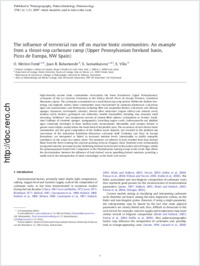The influence of terrestrial run off on marine biotic communities: An example from a thrust-top carbonate ramp (Upper Pennsylvanian foreland basin, Picos de Europa, NW Spain)
- Merino-Tomé, Óscar Instituto Geológico y Minero de España, Parque Científico de León, Spain
- Bahamonde, Juan R. Department of Geology, Oviedo University, Faculty of Geology, Spain
- Samankassou, Elias Département de Géosciences, Géologie et Paléontologie, Université de Fribourg, Switzerland - Dept. of Sedimentology and Marine Geology, Vrije Universiteit Amsterdam, The Netherlands - Section of Earth and Environmental Sciences, University of Geneva, Switzerland
- Villa, E. Department of Geology, Oviedo University, Faculty of Geology, Spain
-
14.04.2009
Published in:
- Palaeogeography, Palaeoclimatology, Palaeoecology. - 2009, vol. 278, no. 1-4, p. 1-23
English
High-diversity marine biotic communities characterize the lower Kasimovian (Upper Pennsylvanian) carbonates of the Las Llacerias Formation in the Ándara Massif (Picos de Europa Province, Cantabrian Mountains, Spain). The carbonates accumulated on a small thrust-top ramp system. Within the shallow, low-energy and euphotic realms, biotic communities were characterized by abundant photozoans (calcareous algae and cyanobacteria) and heterozoans including filter and suspension feeders (calcareous and siliceous sponges, bryozoans, brachiopods, crinoids), diverse other metazoans (rugose solitary and colonial corals, tabulate corals, bivalves, gastropods and echinoids), benthic foraminifers including very abundant small incrusting “tubiforms” and conspicuous swarms of cement-filled spheres (calcispheres or Penella). Small-sized buildups of chaetetid sponges, syringoporids, branching rugose corals, Anthracoporella and phylloid algae commonly developed in these shallow-water environments. Meanwhile, mud mounds formed at greater water depths, mostly below the lower limit of the phothic zone. The occurrence of such diverse biotic communities and the grain composition of the shallow-water deposits, not recorded in the platform-top successions of the antecedent Bashkirian–Moscovian carbonate shelf (Valdeteja and Picos de Europa formations) are interpreted as linked to increased nutrient levels (mesotrophic to mildly eutrophic conditions) in the actual sea-surface water. The nutrients are inferred to have resulted from land-derived fluxes from the rivers draining the adjacent growing Variscan Orogenic chain. Nutrients were subsequently transported into the narrowed marine shallowing foreland basin located in the eastern side of Pangea, within the palaeoequatorial humid belt. Comparison to the Pennsylvanian Auernig Group in the Carnic Alps allows the discrimination between the influence of land-derived versus upwelling-derived nutrients, providing a useful tool in the interpretation of biotic assemblages in the fossil rock record.
- Faculty
- Faculté des sciences et de médecine
- Department
- Département de Géosciences
- Language
-
- English
- Classification
- Palaeontology
- License
-
License undefined
- Identifiers
-
- RERO DOC 12504
- DOI 10.1016/j.palaeo.2009.04.002
- Persistent URL
- https://folia.unifr.ch/unifr/documents/301357
Statistics
Document views: 132
File downloads:
- pdf: 220
